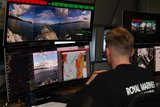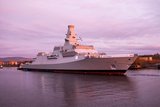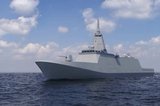South Africa’s IPV programme completes landmark stage
Equipped with OSI Maritime Systems integrated navigation and tactical systems, the lead vessel of the South African Navy’s three-ship class of IPV’s recently concluded the First Article Acceptance Test, a landmark stage in the programme’s development.
Being built by Damen Shipyards Cape Town in South Africa, the multi-mission IPVs (MMIPV) will be used for coastal security activities such as maritime patrol and securing the country’s EEZ.
‘I’d sum up the MMIPV as a patrol vessel with big capacity,’ stated Jim Davison, VP, business development at OSI. ‘It was a very interesting project for OSI, as we applied solutions to this compact vessel that are typically found on bigger or combat ready ships.’
For the South African progamme, dubbed Project Biro, OSI fitted the IPV with a navigation and tactical suite that included the company’s Tactical Asset Control and Tracking and Integrated Mission Management System.
In addition, the company’s warship electronic chart and display system, certified to NATO STANAG 4564, is integrated into critical sensor inputs including X-band and S-band radars, INS and GPS module, among others.
According to Defence Insight data Project Biro will see each IPV delivered at an estimated cost of £33.6 million.
Related Equipment in Defence Insight
More from Naval Warfare
-
![NATO tests use of “undetectable, jam-proof” laser communication in maritime scenarios]()
NATO tests use of “undetectable, jam-proof” laser communication in maritime scenarios
As part of its effort to better prepare its capabilities for operations in contested and congested scenarios, NATO evaluated a Lithuanian ship-to-ship terminal designed to not be susceptible to enemy interference.
-
![US Navy advances with the Harpoon Service Life Extension Programme]()
US Navy advances with the Harpoon Service Life Extension Programme
The US Navy plans to improve Harpoon’s anti-ship and land attack capabilities by equipping the missiles with sensors and technologies required for succeeding in future battlespace.
-
![Mitsubishi eyes future with Australia’s Mogami selection]()
Mitsubishi eyes future with Australia’s Mogami selection
With Australia’s selection of the Mogami-class for Project Sea 3000, Mitsubishi is investigating local production in the next decade as potential export opportunities emerge.
-
![Thales’ new Sonar 76Nano could equip UK Royal Navy on anti-submarine warfare missions]()
Thales’ new Sonar 76Nano could equip UK Royal Navy on anti-submarine warfare missions
The new sonar is designed to equip uncrewed underwater vessels, with the potential to be used by the Royal Navy for its Atlantic Bastion and Atlantic Net missions.
-
![Hanwha wins Australian government approval to increase its stake in Austal]()
Hanwha wins Australian government approval to increase its stake in Austal
The contract would mean the two shipbuilders can collaborate strategically and enhance shipbuilding capabilities in Western Australia.
























